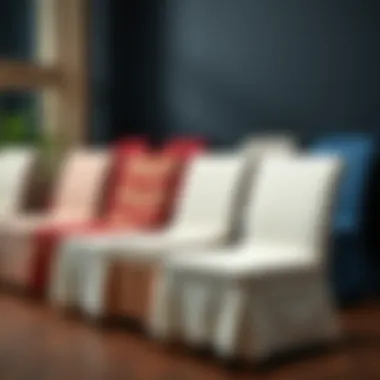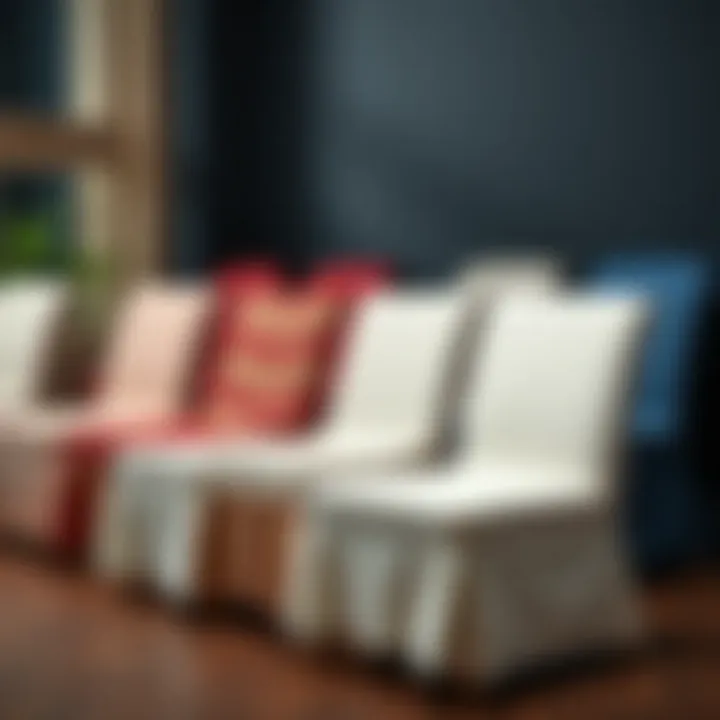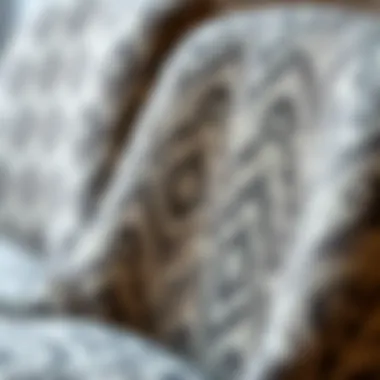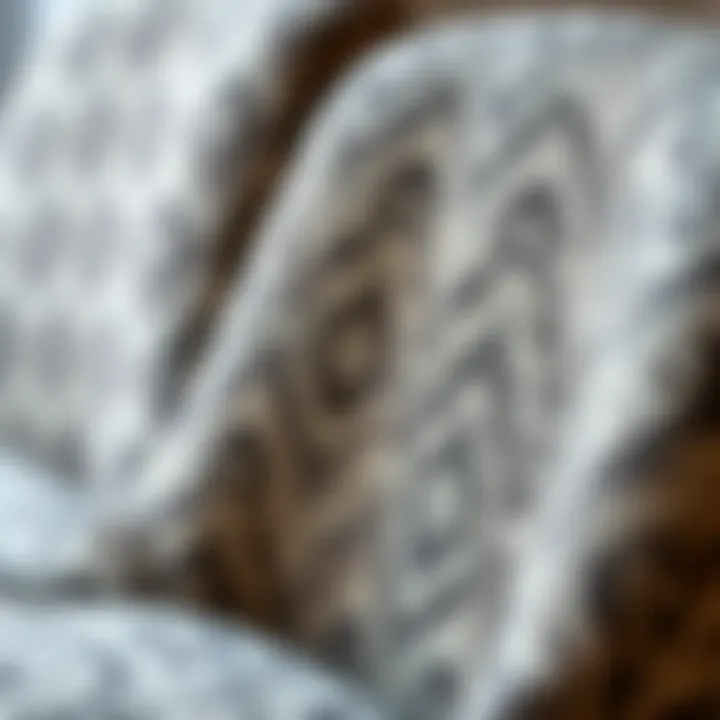Furniture Covers for Chairs: Enhance Your Decor


Intro
When it comes to enhancing the aesthetic appeal and functionality of chairs, furniture covers can be game changers. They don’t just protect your beloved seating but can also breathe life into your interior design. Imagine draping a well-crafted cover over that worn-out armchair, instantly transforming it from a drab corner into a chic focal point. This guide will delve into the various aspects of chair covers, their significance in home decor, and how to choose the right one to suit your style and needs.
Furniture Design Trends
Current Styles and Themes
In the world of interior design, trends come and go like passing ships. Currently, there is a strong inclination toward minimalism and sustainability. Furniture covers that embody these principles are typically simple in design and made from eco-friendly materials. Think about neutral tones, clean lines, and functionality over frills.
On the other hand, if you lean more towards maximalism, bright colors and bold patterns can add personality to your space. Covers adorned with floral prints or geometric designs can bring a sense of vibrancy and creativity to any room. Likewise, vintage or classic themes have made a notable comeback. A well-chosen chair cover can echo the styles of decades past, creating a warm and inviting ambiance.
Color Palettes and Materials
Color is not just a visual stimulation; it can affect moods and perceptions. Soft pastels, deep jewel tones, and earthy hues are worth considering when selecting chair covers. Each color can evoke different feelings—from calmness to energy, so choose wisely based on the atmosphere you wish to create in your space.
Materials used for chair covers also play a crucial role. Common options include:
- Cotton: Breathable and easy to clean
- Polyester: Durable and resistant to fading
- Linen: Luxurious look, yet requires more upkeep
- Microfiber: Soft to touch and stain-resistant
Mixing and matching these materials in different areas of your home can add depth and texture.
Practical Furniture Tips
How to Choose the Right Size
When it comes to chair covers, sizing is half the battle. A cover that doesn’t fit well can ruin the entire look. Here are a few tips to ensure you get a perfect fit:
- Measure your chair’s dimensions—width, height, and depth.
- Check for specific style fit—armchair, recliner, or dining chair.
- Refer to product descriptions carefully, as brands often provide size guidelines.
By following these steps, you can avoid the embarrassment of a cover that’s too baggy or snug, and instead, opt for one that hugs the chair just right.
Maintenance and Care for Longevity
Keeping your chair covers in tip-top shape requires a little diligence. Regular maintenance ensures that your investments last. Here are some straightforward tips to consider:
- Wash regularly: Follow label instructions for washing. Some are machine washable, while others may need dry cleaning.
- Rotate covers: If you have multiple sets, rotating them can minimize wear on a single cover.
- Spot clean immediately: Any spills should be addressed right away to prevent staining.
“A stitch in time saves nine” – this old saying rings true here; a little care goes a long way.
Embracing the right covers for your chairs can elevate your living space while adding a layer of protection. With trends leaning towards both sustainable and bold choices, the options for expressiveness in your decor are endless. Understanding considerations around sizing and maintenance can help ensure that your investment not only looks good but stands the test of time.
Foreword to Furniture Covers for Chairs
Furniture covers for chairs can often be an overlooked aspect of home decor, yet they play a significant role in both aesthetics and protection. In a world where style converges with practicality, understanding chair covers becomes essential for homeowners and interior decorators alike. They aren't merely decorative; they serve a practical purpose that has grown in importance over the years. Amidst changing tastes and the wear and tear of everyday life, these covers help maintain the integrity of furniture while adding a layer of personalization to living spaces.
Defining Furniture Covers
Furniture covers, specifically for chairs, are protective wraps that are designed to shield seating from spills, wear, and allergens from dust and pet hair. They come in various forms, including fitted slipcovers, stretchable fabric, and tailored options that suit specific furniture styles. Rather than simply hiding a chair's original fabric, these covers are a way to enhance or transform a chair's appearance. They come in a variety of colors, textures, and patterns, allowing for individual expression that matches any home decor theme. Thus, they provide a dual advantage of protection and design.
The choice of cover can reflect the personality of the home and its inhabitants, making it an integral part of interior design. Because chair covers are available in different materials and styles, they can suit both modern minimalist settings and more eclectic or traditional homes. This versatility ensures that anyone can find suitable options for their unique design needs.
Historical Context
The history of chair covers can be traced back to a time when furniture was crafted primarily from natural materials, which needed protection from everyday use. In earlier centuries, when seating was often made of expensive or delicate woods, covers were utilized as a means to preserve these costly investments. For instance, during the Victorian era, intricate and ornate fabrics were used not only as decorative elements but also as a form of protective layering, ensuring that the opulent chairs of the time would withstand the onslaught of daily living.
Fast forward to the 20th century, with the influence of mass production and the rise of synthetic materials, chair covers took on an additional function — that of easy maintenance and upgrade. The affordability of fabrics like polyester made it possible for a wider audience to experiment with stylish chair covers. Today, historical influences meld with contemporary sensibilities, creating a rich tapestry of options for every taste and requirement in furniture covers for chairs. People looking to add flair to their homes or improve the longevity of their furniture have a bounty of choices at their fingertips, further illustrating the ever-evolving relationship between function and design in home furnishings.
While the modern chair cover appears simple, its history is steeped in practicality and artistry, making it a fascinating topic for those interested in home decor.
The Importance of Chair Covers
In the realm of interior design, it is often the little things that make a massive impact. Chair covers stand as an example of this principle. Beyond being mere fabric drapes thrown over furniture, these covers play a crucial role in protecting, enhancing, and beautifying our living spaces. Understanding the importance of chair covers is essential for any homeowner, decorator, or enthusiast looking to elevate the ambiance of their interiors.
Protection from Wear and Tear
One of the most practical roles of chair covers is to provide a shield against everyday wear and tear. Let's face it—life happens. Whether it's spilled coffee during a morning rush or muddy footprints from a misplaced fun weekend, our chairs are often at the mercy of accidents and the normal hustle of day-to-day living. That's where chair covers come into play.
These protective layers can significantly preserve the integrity of the fabrics underneath. They absorb stains and prevent grime from embedding itself into the upholstery. An effective cover will not only prevent damage but can also be vastly easier to clean than the underlying furniture itself. Instead of fretting over a stubborn stain, you can simply toss the cover into the washing machine and breathe a sigh of relief.
Furthermore, certain materials like denim and heavy-duty polyester offer exceptional durability. For households with children or pets, investing in robust chair covers can save you a bundle in potential upholstery repairs or replacements down the line. By acting as a proactive barrier, chair covers ensure that the beauty of your chairs stays intact more easily despite the myriad challenges of everyday life.
"An ounce of prevention is worth a pound of cure."
This adage couldn't be truer when it comes to maintaining the beauty of your chairs through the use of chair covers.
Enhancing Aesthetic Appeal
Beyond their functional aspects, chair covers are also a brilliant tool for sprucing up the aesthetic appeal of your space. Think of them as the cherry on top of an already stylish cake. With a vast array of colors, patterns, and textures available, chair covers can transform the mood of a room with relative ease. From sleek and sophisticated looks to vibrant and playful motifs, the options are practically endless.
Moreover, they allow you to express your personal style and adapt the decor according to seasons or events. A floral pattern might bloom splendidly in spring, while deep earthy tones can create cozy vibes during autumn. Incorporating chair covers into your design strategy offers flexibility. You can tailor your environment to reflect your preferences or even the themes of specific gatherings.
For professional interior decorators, chair covers offer an opportunity to distinguish a space. Pairing a classic slipcover with modern throw pillows can harmonize various elements around the room, bringing a seamless flow that captivates the eye. In doing this, homeowners and designers alike can wield chair covers as transformative tools.
Types of Chair Covers
When it comes to enhancing home decor, the type of chair cover chosen can significantly impact both the aesthetics and functionality of living spaces. Each style serves a distinct purpose, blending into specific environmental themes while offering protection and comfort. These covers aren’t merely decorative; they serve as an investment in your furniture's longevity and character. Whether you favor a classic, contemporary, or quirky style, the type of chair cover can reflect your personal taste while protecting your seating.
Stretchable Covers


Stretchable chair covers are made from flexible fabrics, typically blending polyester with spandex. They hug the curves of chairs tightly, creating a smooth and streamlined appearance. This snug fit is particularly advantageous for homeowners seeking to revamp their furniture without undertaking a significant financial commitment. Moreover, the elastic nature of these covers allows for easy installation and removal, making them practical for everyday use.
The beauty of stretchable covers lies in their adaptability. With a plethora of colors and patterns available, they can be swapped out seasonally or as preferences evolve. When considering this option, homeowners should be mindful of the chair's size. While stretchable covers tend to fit a range of chair designs, they perform best on chairs with simple shapes, avoiding those with intricate details. Not only do they protect against spills and stains, but they also offer a fresh look with minimal effort.
Tailored Covers
Tailored covers are the antithesis of stretchable options. These are custom-made, fitted specifically to a chair's unique dimensions and design features. The precision in tailoring means they drape elegantly, preserving the original design of the furniture. However, this also comes with a higher price tag, as bespoke options require more time and craftsmanship.
Homeowners often opt for tailored covers when they want to maintain the integrity of their furniture while also investing in its protection. These covers are perfect for high-end or antique chairs where the shape and style are important to retain. One key consideration for potential buyers is the material used for tailored covers; they can be made from luxurious fabrics like silk or sturdy options like denim. When selecting a tailored cover, it’s wise to have specifics, including an accurate measurement of the chair, to ensure a perfect fit.
Slipcovers
Slipcovers offer a practical yet stylish solution, especially for families or anyone who values ease of maintenance. These covers typically allow for quick changes, providing ample protection against daily wear and accidental spills. Made from various materials, slipcovers can embody a more casual look while still looking chic.
Often, slipcovers are designed to be machine washable, making them a favorite for busy households or for those with furry friends. One distinct advantage is their ability to transform an old piece of furniture into something that feels brand new with just a simple cover change. Every slipcover can be taken off and thrown in the wash, presenting a no-fuss cleaning alternative.
Benefits of Slipcovers:
- Easy to clean and maintain
- Cost-effective
- Versatile in styling
- Quick to change for different seasons
In summary, the choice between stretchable covers, tailored covers, and slipcovers largely depends on personal needs, design preferences, and the function of the space. While stretchable covers offer versatility, tailored versions create a timeless elegance. Meanwhile, slipcovers can add charm while ensuring that protection doesn’t take a backseat to aesthetics. No matter the choice, each type of cover can breathe new life into your living space.
Materials Used in Furniture Covers
When diving into the world of furniture covers, grasping the various materials available is fundamental. The choice of fabric not only affects the durability and maintenance of the cover but also plays a crucial role in aesthetics and comfort. Different materials provide unique qualities that can cater to specific needs, whether it’s resilience against spills or a soft touch for added comfort. Let's stroll through the most popular options and consider what each brings to the table.
Cotton and Polyester Blends
Cotton and polyester blends strike a harmonious balance between comfort and utility. Cotton is known for its softness and breathability, making it a favored option for those who prioritize touch. On the other hand, polyester enhances durability and helps the cover resist wrinkles, fading, and shrinking. This blend is often machine washable, which is a major plus for busy households.
- Benefits:
- Offers a comfortable texture against the skin.
- Easy to clean and maintain compared to 100% cotton.
- Retains colors well, reducing the need for frequent replacements.
However, not all cotton-polyester blends are created equal. It's wise to look at the thread count and the quality of the polyester used. Higher thread counts often yield softer and sturdier fabric, ensuring your chair cover will withstand the test of time.
Vinyl and Leather Options
For a sleek and sophisticated look, vinyl and leather are often top contenders. Vinyl is liquid-resistant and incredibly easy to clean, making it a common choice for dining chairs or any space where spills might occur. Similarly, genuine leather exudes elegance and provides a luxurious feel that elevates any room's decor.
Pros and Cons:
- Vinyl:
- Leather:
- Advantages:
- Disadvantages:
- Budget-friendly and easy to maintain.
- Wide variety of colors and textures available.
- Less breathable, which can be uncomfortable in hot climates.
- Advantages:
- Disadvantages:
- Long-lasting and can develop a beautiful patina over time.
- Adds a touch of luxury to any space.
- Higher initial investment and requires regular conditioning to maintain.
Choosing between vinyl and leather often boils down to personal preference and budget. Each material serves a different purpose, whether for practicality or sheer aesthetic value.
Eco-Friendly Fabrics
In an age where sustainability is at the forefront of discussions, opting for eco-friendly fabrics when selecting chair covers is a wise choice. Materials such as organic cotton, linen, and reclaimed textiles are gaining momentum among environmentally conscious consumers. These materials not only minimize environmental impact but also contribute to healthier indoor air quality by reducing harmful chemicals often found in conventional fabrics.
- Sources of Eco-Friendly Fabrics:
- Benefits:
- Look for certifications like Global Organic Textile Standard (GOTS).
- Consider recycled fabrics such as those made from PET bottles.
- Biodegradable and hence, better for the planet.
- Often softer and more natural, providing a comfortable feel.
Selecting eco-friendly options reflects a commitment to sustainability and can resonate well with a growing demographic of consumers who prioritize ethically made products. Not only can these materials enhance your home decor, but they also contribute positively to the environment, making them a smart choice for modern homeowners.
"By choosing eco-friendly chair covers, you’re making a statement about your values while enhancing your home environment."
In summary, the materials used in chair covers are crucial in determining their overall functionality and aesthetic appeal. Understanding the properties of cotton blends, leather, and eco-friendly options ensures that your choice aligns with both practicality and personal style.
Choosing the Right Chair Cover
Selecting the right chair cover is far more than simply picking a fabric; it’s an exercise in personal expression and practicality. In a world where trends ebb and flow like the tide, and where chairs can quickly become victims of spills and stains, chair covers represent a fusion of adaptability and aesthetics. Understanding key aspects before making a choice can save not just your furniture, but also your sanity.
Assessing Your Needs
Before diving into the plethora of options available, it is advisable to take a good long look at your specific needs. Think about what exactly you're hoping to achieve with a chair cover. Are you trying to protect furniture from pets who think they own the joint? Or perhaps you want to refresh a tired-looking space without shelling out for new furniture.
Consider these factors:
- Durability: If your chairs see heavy use, consider covers made from thicker, more resilient materials.
- Washability: Some fabrics resist stains better than others. Can you toss the cover in the washing machine, or will it require special care?
- Allergies: If allergies are a concern, opt for materials that are hypoallergenic.
- Budget: Understand what you’re willing to spend. There are options that cater to every price range.
By considering these elements, you’ll be better equipped to narrow down your choices. The best chair covers cater to your functional requirements while still offering a stylish touch.
Considering Style and Theme


Now that you know what you need, it’s time to think about how the chair cover fits into the bigger picture of your space. The style of your furniture and overall decor theme will guide your selection significantly. Your chair cover should harmonize with your existing design without clashing or overwhelming.
Some tips to keep in mind:
- Color Palette: Choose colors that either match or complement the existing decor. If your room consists of earthy tones, a deep green or rust might do wonders.
- Patterns: From floral to geometric, the pattern on the cover can either create a focal point or blend into the background. Keep in mind your audience—is it a family-friendly space, or more refined?
- Functional Areas: For high-traffic areas, patterns that hide stains or pets' hair can be a wise choice.
A thoughtfully chosen cover can not only transform a chair but also add an element of cohesion to your room while allowing it to shine.
Measuring Your Chairs
No one wants to play the guessing game when it comes to fit. A cover that’s too loose will end up like a baggy pair of pants, while one that’s too tight can make your beautiful chairs look like they’re suffocating. Accurate measurements are essential in this decision-making process.
To measure effectively, follow these steps:
- Height: Measure from the floor to the top of the chair back.
- Width: Assess the widest part of the chair—don’t forget any armrests!
- Depth: Gauge the depth of the seat, especially if you have plush cushions involved.
- Skirt Length: If your chair has a skirt or any ornate details, consider how the cover will set over those aspects.
By getting these measurements right, you’re setting yourself up for success in choosing a cover that will fit like a glove. No more awkward bunching or excess fabric!
"The right chair cover can alter the entire character of a room, lending both sophistication and charm."
Choosing the right chair cover is decisively about balancing need, style, and fit. Taking the time to assess each of these factors can lead to a much more satisfying and enriching experience in enhancing your living space.
Installation and Usage
Proper installation and usage of chair covers not only ensure their effectiveness but also maintains the aesthetic appeal of your space. A well-fitted cover can transform the ordinary into the extraordinary, giving your furniture a fresh appearance while safeguarding it from life’s little mishaps. From family gatherings to casual evenings, these covers provide a relevant functionality that extends the life of your chairs. Here, we’ll outline some crucial steps and tips for installation, ensuring that you get the most out of your investment.
Step-by-Step Installation Guide
Installing chair covers correctly is key to optimal performance. Here's a straightforward guide to help you through the process:
- Preparation: Begin by gathering your materials. You’ll need your chosen chair cover, a measuring tape, and possibly a friend to assist.
- Measure Your Chairs: Before you pull out the brand-new cover, measure the height, width, and depth of your chair. This helps in selecting the most suitable fit and prevents any surprises during installation.
- Slip It On: If your cover is a slipcover, start by draping it over the chair, starting from the back. Make sure to keep it centered as you lower it over the seat.
- Adjust for Fit: Once on, gently tug the fabric to ensure it's sitting neatly around the bottom edges of your chair. It should be snug but not overly tight. If you have a stretchable cover, you may be able to adjust the fabric to reduce any excess.
- Secure it Down: If your cover comes with ties or fastenings, use them to keep it in place. For additional security, consider using non-slip pads underneath the fabric to prevent sliding.
- Final Touches: Smooth out any wrinkles or creases, giving your chair a polished look.
By following these steps, you can install your chair covers with relative ease, bringing a fresh vibe to your space in no time!
Tips for Secure Fit
A secure fit doesn’t just enhance the appearance; it also increases functionality. Here’s how to ensure your chair covers stay in place:
- Tighten the Straps: If your cover features straps or ties, make sure to tighten them fully to prevent slippage.
- Use Non-Slip Pads: Placing non-slip pads under the cover can significantly decrease the likelihood of movement, especially on leather or wooden surfaces.
- Choose the Right Size: Always select covers that are specifically designed for your chair type. A loose fitting cover will likely bunch up or slide around.
- Regular Maintenance Checks: Every now and then, take a few moments to check if the cover is still secure. Adjust as necessary, especially after hosting guests.
Remember: A cover that fits snugly not only looks better but also protects your chair more effectively. Your efforts will pay off as you enhance both the comfort and longevity of your furniture.
In summary, installation and proper usage of chair covers plays a pivotal role in maximizing their benefits. Following the outlined steps and considering the fit will save you time and assist in maintaining a chic and functional living space. For more tips on furniture care, you might find resources on Wikipedia helpful.
Maintenance of Chair Covers
Maintaining your chair covers is essential to ensure they last longer and continually enhance the beauty of your home. Proper maintenance not only keeps your furniture looking sharp but also prevents costly replacements or repairs. With the right care, those covers can endure the daily wear and tear of family life, pets, and the occasional spill, serving as dependable protectors for your favorite seating.
Cleaning Techniques
Regular cleaning is crucial for showcasing the aesthetic appeal of your chair covers while also prolonging their life span. Each material could have a slightly different way to keep it in top shape, so knowing the right methods is key. Here’s a rundown of general cleaning techniques:
- Read Labels: Always check the manufacturer’s instructions regarding cleaning. Some fabrics can be machine washed, while others may require a gentle hand wash or dry cleaning.
- Vacuuming: For light dirt or pet hair, a quick vacuuming session can work wonders. A soft brush attachment is highly recommended for minimizing damage to the fabric.
- Spot Cleaning: For persistent stains, use a gentle detergent mixed in warm water. Apply a small amount to the stain and dab gently with a clean cloth; avoid vigorous scrubbing to prevent wear.
- Machine Wash: For machine-washable covers, consider using cold water and a gentle cycle. It’s wise to wash dark-colored fabrics separately to avoid color transfer. Add a mild detergent for best results.
- Drying: Air-drying is often the best approach. If you must use a dryer, opt for a low heat setting to prevent shrinking or fabric damage.
"An ounce of prevention is worth a pound of cure." Regular maintenance can prevent major issues down the line.
Storage Recommendations
Storing chair covers properly when not in use plays a significant role in their longevity. Here are some practical tips:
- Clean Before Storage: Make sure they’re clean and dry before tucking them away. Any moisture can lead to mildew, while dirt can cause permanent stains or odors.
- Roll, Don’t Fold: When putting them into storage, rolling them rather than folding can help prevent crease marks.
- Use Breathable Bags: If you’re storing covers for long periods, consider using breathable fabric storage bags instead of plastic. This prevents moisture build-up while deterring pests.
- Cool, Dry Place: Store in a place that’s cool and dry. Avoid attics or basements where temperature fluctuations could cause damage.
By keeping these cleaning techniques and storage recommendations in mind, you can ensure that your chair covers remain both functional and stylish for years to come.
The Aesthetic Impact of Chair Covers
Chair covers do more than just preserve the life of your furniture; they can radically transform a room’s atmosphere. The aesthetic impact of these accessories should not be underestimated; they are an artful blend of design, color, and form. A thoughtfully chosen chair cover can reflect your personality, enhance your space and contribute to a cohesive look throughout your home.
When considering the aesthetic appeal of chair covers, it’s important to examine a couple of key elements: color coordination and texture. Both play a crucial role in tying rooms together and creating that inviting space we long for.
Color Coordination
Color coordination is the lifeblood of good interior design. It’s the conversation starter in any room. A chair cover that contrasts or complements the color of your walls, curtains, and other furniture creates harmony. Having a neutral-toned couch might seem simple, but when paired with vibrant chair covers, it injects a level of excitement into the decor.
To get this right, here are some pointers:
- Hues that Speak: Choose colors that resonate with your overall theme. Earthy tones bring a sense of calm, while bright colors evoke energy.
- Accent Colors: If your living space boasts a color palette with various accent colors, consider using chair covers in those shades. This ties everything together nicely. For instance, a navy blue chair cover paired with coral cushions or curtains can make a bold yet stylish statement.
- Seasonal Choices: You can also switch covers according to seasons. Warm, rich colors in autumn, cool blues and greens in spring—this keeps your decor fresh and interesting year-round.
"A chair cover is not just a protective layer; it is a canvas for creativity that speaks volumes about the aesthetic of a room."
Utilizing these color-coordination strategies can profoundly affect how visitors perceive your space. A carefully curated palette can transform a mundane room into a visually stimulating haven.
Texture Considerations
Texture is yet another essential aspect of chair covers that can elevate the decor. Different materials provide variety and add layers to your design. Textural disparity can create depth, ensuring that your space is visually appealing.
Here are a few considerations regarding texture:
- Visual Weight: Heavy fabrics, like velvet, impart a sense of luxury, making a room warm and inviting. Conversely, lighter fabrics such as linen can evoke an airy and casual vibe.
- Layering: Combining different textures within one room can create a rich sensory experience. For instance, pairing a soft, knitted chair cover with a sleek leather sofa offers a pleasing contrast that keeps the eye wandering.
- Durability vs. Feel: While some materials may feel plush and soft, they might not always be the best for wear and tear. Balance aesthetics with practicality. After all, the chair cover is not just a decorative piece; it’s a workhorse in your living space.


Being mindful of how color and texture interplay can help you create an environment that feels both curated and lived-in. Ultimately, the aim is to harmonize all the elements in your room to sculpt an inviting atmosphere that reflects your unique taste.
Integrating these thoughtful approaches to aesthetics can greatly enhance not just the look of your chairs, but also the entire ambience of your home.
Chair Covers for Special Occasions
In the realm of interior design, chair covers can play a critical role during special occasions. It's not just about aesthetics; these covers contribute both to the ambiance of an event and the protection of the furniture beneath. Whether you are celebrating a family gathering, a wedding, or a festive holiday, choosing the right chair cover can elevate your decor and ensure your furniture remains pristine.
The importance of chair covers during special events cannot be overstated. Not only do they allow you to express the theme or spirit of the occasion, but they also help in maintaining the longevity of your furniture. Covers can be used to hide imperfections or wear on chairs, creating a refreshed appearance. Plus, the right choice can transform a mundane space into something breathtaking, ensuring that your furniture seamlessly blends with the overall theme, captivating your guests' attention.
Seasonal Variations
Seasonal changes usher in different vibes and themes, prompting many to alter their home decor accordingly. Chair covers tailored to the seasons can breathe life into your space, aligning your furniture with the mood of the time. For instance, during winter, opting for thick, textured materials in rich hues can create a warm and cozy atmosphere. Conversely, in spring, light cotton or linen covers in pastel shades can evoke feelings of freshness and rejuvenation.
- Spring: Light and airy fabrics in floral or pastel colors inject a sense of life into your home.
- Summer: Bright, bold patterns can bring about an energetic vibe, fitting for casual gatherings.
- Autumn: Earthy tones and thicker fabrics enrich your decor, making it inviting as the temperatures drop.
- Winter: Opt for plush covers that offer comfort while appearing festive.
Dressing your chairs in seasonal covers not only brings variety but can also be a fun endeavor, reflecting your creative spirit in home decor. Remember, matching the colors with the seasonal decor, like floral arrangements or table settings, can amplify the overall effect.
Event-Specific Styles
Some occasions call for specific styles of chair covers that align more closely with the intended atmosphere. Think of a formal dinner; an event like that may benefit from sleek, tailored covers in luxurious fabrics that add elegance to your dining experience. On the other hand, a casual barbecue might only need slipcovers made of stain-resistant materials, ready to withstand anything thrown their way.
Different events require distinct style choices and knowing the specifics can guide you:
- Weddings: Choose covers with intricate lace detailing or satin finishes for an air of sophistication.
- Birthdays: Bright, playful covers can match themed decorations, enhancing the celebratory mood.
- Holiday Gatherings: Festive colors like red and green or covers adorned with holiday motifs bring joy and unity to your decor.
- Formal Events: Opt for classic colors like navy or ivory with sleek lines to elevate the setting.
"The chair covers you choose can significantly impact the perceived atmosphere of your gathering, so choose wisely."
DIY Chair Cover Projects
Creating your own chair covers is not just about saving a few bucks; it's a fantastic opportunity to showcase your creativity and tailor the décor to your personal style. DIY projects can breathe life into tired pieces of furniture, transforming them into unique statements in your home. Furthermore, making chair covers allows for a more customized fit and aesthetic that off-the-shelf options often lack.
Undertaking a DIY chair cover project can bring a sense of satisfaction and pride, knowing that you've handcrafted an item with your own two hands. It’s also an eco-friendly choice, as you can repurpose materials or choose sustainable fabrics. Ultimately, this kind of project combines functionality with artistic expression, catering well to those who appreciate both means of home decor.
Materials and Tools Needed
Before diving into your DIY chair cover project, gather all necessary materials and tools. Having everything on hand streamlines the process and helps prevent any frustrating interruptions. Here’s a list of essentials:
- Fabric: Choose a durable fabric that matches your décor style. Options like cotton, linen, or a polyester blend work well.
- Measuring Tape: Accurate measurements are critical for a snug fit.
- Sewing Machine or Needle and Thread: A machine can speed up the process, but hand sewing works just as well.
- Scissors: Sharp scissors for cutting fabric.
- Pins or Fabric Clips: Useful for holding the fabric in place while you sew.
- Iron: To smooth out the fabric before and after sewing, ensuring clean seams.
- Pattern Paper: If you're using a specific design, creating a pattern can be beneficial.
Step-by-Step Instructions
Follow these instructions to create your chair cover with ease. It might seem daunting at first, but taking it step by step helps to simplify the process:
- Measure Your Chair: Start by measuring the dimensions of your chair. Take notes of the width, depth, and height to ensure a correct fit.
- Choose and Cut Fabric: Determine the amount of fabric needed based on your measurements. Add an extra couple of inches for hems. Cut the fabric according to your pattern or dimensions.
- Pin the Fabric: Before sewing, lay the fabric over the chair and pin it to maintain the desired shape. You might want to drape it loosely to see how it looks before finalizing the fit.
- Sew the Fabric: Using a sewing machine or needle and thread, start sewing the edges of the fabric. If you want, create pockets or tucks for a more structured look.
- Test Fit the Cover: After sewing, place the cover on the chair to see how it fits. Check for adjustments – does it seem too tight or loose?
- Finish the Edges: Hem the edges where necessary to avoid fraying. An iron can help give the seams a finished look while ensuring crisp edges.
- Decorate if Desired: Use additional embellishments, such as buttons or frills, if you’re feeling adventurous.
- Final Placement: Once all adjustments are made, place the cover on your chair, ensuring it fits snugly.
Making your own chair cover is not only a practical choice but also allows you to imprint your personality on your home’s aesthetics. With a bit of time and creativity, you can achieve results that are just as stylish as anything you might purchase.
"The best part about DIY projects is they give you ownership over your space, allowing you to express who you are through your choices."
For more tips on sewing and crafting, you might want to check out resources available at wikihow.com or various crafting forums on reddit.com. Whether it's your first time or you're a seasoned DIYer, enjoy the process and let your imagination flourish!
Future Trends in Chair Covers
As we continue to evolve in our understanding of interior design and furniture care, chair covers have also stepped into the spotlight with innovative solutions. The future of chair covers is undoubtedly tied to both aesthetic enhancement and significant practicality. With more focus on sustainability and technology, these emerging trends are reshaping how we view furniture protection and style.
In the world of home decor, the importance of chair covers can't be overstated. They not only serve to protect our beloved chairs but also provide an opportunity to express personal style. The intersection of durability, eco-friendliness, and style is what makes these trends particularly notable in today’s marketplace. The growing awareness about the environmental impact of our choices has propelled manufacturers and designers to think differently, resulting in a myriad of innovative products that marry function with environmental responsibility.
Innovative Materials
A prominent trend in the chair covers landscape is the shift towards innovative materials that cater to both sustainability and functionality. Traditional materials like cotton and polyester are being supplemented, if not replaced, by newer alternatives that boast enhanced properties.
- Recycled Fabrics: More brands are looking to repurpose plastic bottles and old textiles to create new fabrics. This not only offers a sustainable option but also ensures durability, making these covers resistant to spills and everyday wear.
- Natural Fibers: Fabrics made from hemp or bamboo are gaining traction due to their biodegradable nature and aesthetic appeal. They often have natural antimicrobial properties, making them suitable for family homes or environments prone to spills.
- Stain-Resistant Coatings: Some manufacturers are experimenting with advanced coatings on standard fabrics which repel liquids and make cleaning a breeze without losing the softness or breathability of the material.
These innovative materials elevate the utility of chair covers while minimizing their environmental footprint. For homeowners and interior decorators alike, incorporating these choices can not only enhance the beauty of a space but also align with growing green initiatives.
Smart Fabrics
With technology advancing at breakneck speed, smart fabrics are emerging as a compelling trend in the realm of chair covers. This leap into textile technology presents chair covers that are responsive to their environment.
- Temperature Regulation: Some smart fabrics adapt to the temperature and humidity of a room, ensuring comfort year-round. This can be particularly useful in spaces that experience fluctuating climates.
- Self-Cleaning Properties: Imagine a cover that doesn’t just resist stains but actively cleans itself! Some materials are being developed with properties that break down dirt and grime, making maintenance a fraction of what it used to be.
- Color Changing: Another fascinating aspect of smart fabrics is the ability for covers to change color or pattern based on temperature or lighting conditions. This can give a space an entirely new feel with just a shift in environmental factors.
Embracing these technologies allows users to have dynamic and multifunctional furniture. For designers, this offers an avenue to work with materials that can drastically change the ambiance of a room.
In summary, the future of chair covers is bright and filled with possibilities. By exploring innovative materials and smart technologies, we’re not only looking at furniture protection but also a revolution in home aesthetics that invites creativity to the forefront. As consumers continue to demand more from their living spaces, chair covers will undoubtedly rise to meet these needs.
End
The discussion surrounding furniture covers for chairs comes full circle with an emphasis on their versatile nature and profound impact on living spaces. This article has navigated through various aspects, emphasizing how these covers are not merely protective fabric, but rather a transformative element in both functionality and aesthetics within a home.
In summary, chair covers play a crucial role in safeguarding furniture against daily wear and tear, which often leaves it looking less than its best. As the hustle and bustle of everyday life takes its toll, these protective layers help maintain both quality and appearance, saving homeowners time and money in the long run. The variety available—stretchable, tailored, and slipcovers—means that there's a suitable choice for any style or preference, making it easy to adapt and change even the most mundane items into statement pieces.
"It's not just about protecting furniture; it's about enhancing the entire room's vibe."
Additionally, choosing the right chair cover can serve as an expression of personal style—an opportunity to coordinate colors, patterns, and textures while embracing current interior design trends.
Recap of Key Points
The significance of using chair covers is multi-faceted:
- Protection: They act as barriers against spills, stains, and wear.
- Aesthetic Enhancement: Chair covers allow for customizability, contributing to the overall decor.
- Ease of Maintenance: Many options are machine washable, making upkeep simple.
- Variety: With various materials and styles, there's a perfect match for every setting.
- Seasonal Adaptability: They provide a simple way to refresh a room's look with the changing seasons or during special occasions.
Final Thoughts on Chair Covers
In the grand scheme of home decor, furniture covers for chairs emerge as both practical and stylish, marrying utility with visual appeal. For homeowners and decorators alike, embracing these covers means understanding that function does not have to come at the expense of style. This balance can either cap off a room's design or spark new trends, showing that with the right choices, even something as simple as a chair can elevate a space. As technology paves the way for smart fabrics and eco-friendly options, the future holds exciting possibilities for how these covers can change our interactions with furniture. The evolution of chair covers mirrors the changing dynamics of our living spaces, reinforcing the idea that thoughtful design can significantly enrich our everyday experiences.



